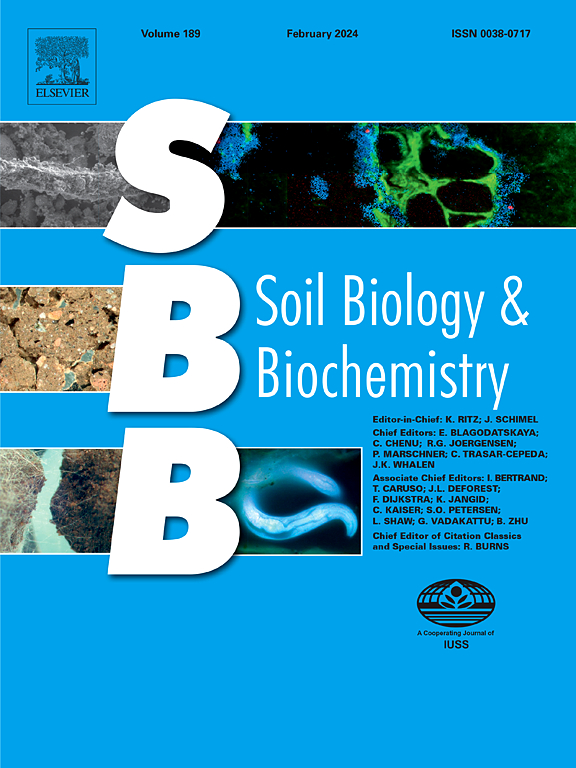The spatial distribution of soil microbial necromass affects nutrient mobilization and beech nutrition on silicate and calcareous forest soils
IF 10.3
1区 农林科学
Q1 SOIL SCIENCE
引用次数: 0
Abstract
Only a little information is available about how the spatial heterogeneity (homogenous vs. patchy distribution) of microbial necromass affects microbial and plant phosphorus (P) and nitrogen (N) nutrition in the rhizosphere of forest soils. Therefore, a rhizotron experiment using soil from two silicate and one calcareous forest site of contrasting nutrient scarcity and P forms was conducted to investigate N and P uptake strategies of microbes and Fagus sylvatica [L.] roots depending on (i) site-specific physico-chemical properties and (ii) availability of 33P and 15N-labeled microbial necromass. The microbial necromass 33P uptake into soil microbial biomass and beech leaves decreased with increasing heterogeneity of necromass. This indicates an improved mobilization of P with a homogeneous necromass distribution especially for P-deficient silicate and calcareous soil. This was in line with increasing effect sizes of alkaline phosphatase activity with rising heterogeneity of microbial necromass. Moreover, we demonstrate site-specific N and P mobilization patterns. Up to 2-fold higher enrichment of residue-derived 15N in leaves and stems for the calcareous than for the silicate soils which reflected a faster mobilization, farther transportation, and greater distribution of 15N into the above-ground biomass, indicating an enhanced beech N nutrition. The different mechanisms governing small-scale necromass N and P distribution are affecting nutrient acquisition strategies of plants and of soil microorganisms in temperate forest ecosystems.
土壤微生物坏死块的空间分布影响着硅酸盐和钙质森林土壤的养分动员和山毛榉营养
微生物坏死块的空间异质性(均匀分布与斑块分布)如何影响森林土壤根际微生物和植物磷(P)和氮(N)营养,目前所知甚少。因此,本研究利用营养稀缺和磷形态对比的两个硅酸盐和一个钙质森林立地的土壤进行根植试验,研究微生物和森林Fagus sylvatica对N和P的吸收策略。根取决于(i)特定地点的物理化学性质和(ii) 33P和15n标记的微生物坏死块的可用性。土壤微生物生物量和山毛榉叶片对微生物坏死块33P的吸收随坏死块异质性的增加而减少。这表明磷的动员得到了改善,特别是在缺磷的硅酸盐和钙质土壤中,磷的坏死团分布均匀。这与碱性磷酸酶活性随着微生物坏死块异质性的增加而增加的效应大小一致。此外,我们还展示了特定地点的N和P动员模式。钙质土壤叶片和茎中残馀源15N的富集量比硅酸盐土壤高2倍,反映了15N在地上生物量中的调动更快、运输更远、分布更广,表明山毛榉的N营养得到了增强。在温带森林生态系统中,控制小尺度necromass N和P分布的不同机制影响着植物和土壤微生物的养分获取策略。
本文章由计算机程序翻译,如有差异,请以英文原文为准。
求助全文
约1分钟内获得全文
求助全文
来源期刊

Soil Biology & Biochemistry
农林科学-土壤科学
CiteScore
16.90
自引率
9.30%
发文量
312
审稿时长
49 days
期刊介绍:
Soil Biology & Biochemistry publishes original research articles of international significance focusing on biological processes in soil and their applications to soil and environmental quality. Major topics include the ecology and biochemical processes of soil organisms, their effects on the environment, and interactions with plants. The journal also welcomes state-of-the-art reviews and discussions on contemporary research in soil biology and biochemistry.
 求助内容:
求助内容: 应助结果提醒方式:
应助结果提醒方式:


